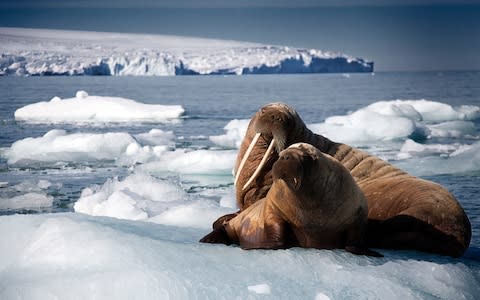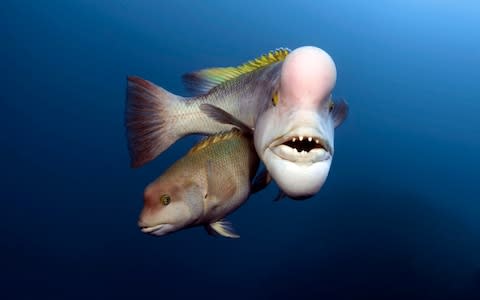Blue Planet II, BBC Two, review: 'The glories just kept on coming'

Action, wonder, and wave after wave of exquisite photography were the keynotes of Blue Planet II (BBC Two, Sunday), the much anticipated sequel to the BBC’s Bafta- and Emmy-winning 2001 series about life above and below the ocean.
It’s been four years in the making, and after just one episode Blue Planet II is already a major new jewel in the BBC Natural History Unit’s seemingly fathomless treasury of peerless wildlife documentaries. Following an introduction in which David Attenborough spoke of how revolutionary new filming technology had allowed the makers to “enter new worlds and shine a light on behaviours in ways that were impossible just a generation ago”, the glories just kept on coming.
Much of what we saw was new even to science. A tusk fish employing an “anvil” to break open a clam; giant wrasse changing sex from female to male; we even looked on as two different species – dolphins and false killer whales – met up, apparently for a mid-ocean chat, before setting off on a joint hunting expedition.
If there was nothing that quite matched up in terms of sheer drama to the “racer snake” sequence in last year’s Planet Earth II, there was plenty that came close. Principally the unique footage of giant trevallies leaping from the sea to snatch birds mid-flight (one sequence was even edited to show a fledgling having a lucky escape – a homage if ever there was one). Footage of orcas herding vast shoals of herring into ever-tighter swirls before knocking them flat with a beat of their tails, was stunning in every sense. Mobula rays, meanwhile, gave us a psychedelic display of submarine phosphorescence.

Some of the most eye-popping sequences didn’t involve wildlife at all, but revealed the power, majesty and beauty of breaking waves in high-definition slow-motion sequences. But the footage that might well stay in most viewers’ minds was that of a female walrus desperately seeking somewhere to land her exhausted calf for a rest, crowded out by other walruses all seeking the same on an ever shrinking area of melting ice. Heart-rending, it was a powerful echo of Attenborough’s opening warning about how “there has never been a more crucial time to reveal what is going on” in our oceans.
Overall though – and despite the original BBC series The Blue Planet being widely criticised back in 2001 for not sufficiently highlighting the environmental damage being inflicted on the oceans – the conservation messages were delivered with a remarkably light touch. And while this new series’ closing episode is rumoured to explore that theme rather more fully and forcefully the emphasis, for now at least, was very much on new discoveries and the wonders of a marine world of which we have yet to learn so much. Especially regarding the behaviour of the creatures that inhabit it.

One mesmerising early sequence was enough to swell any nature-lover’s heart. A large pod of bottlenose dolphins surfing spectacularly along giant rollers thundering in on the South African coast. That they were doing so “for the sheer joy of it” was seen as another sign of the creature’s “extreme” intelligence – something backed up further by evidence uncovered during filming of adult dolphins collectively teaching their calves a life lesson. In this instance how to rub up against a rare plant whose fronds are coated in a mucus containing anti-inflammatory properties.
At the outset Attenborough said Blue Planet II would bring us “creatures beyond imagination” and “a new understanding of life beneath the waves”. He certainly delivered on both those promises in this opening episode. One can only imagine how many more wonders we will be treated to in the weeks to come.